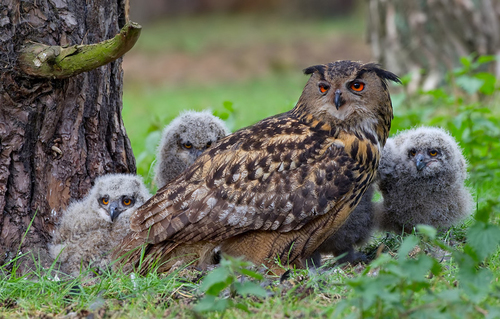
Eurasian Eagle-owl
The Eurasian Eagle-owl (*Bubo bubo*) is one of the largest owl species in the world, renowned for its impressive size, striking orange eyes, and prominent ear tufts. It plays a crucial role as an apex predator in many ecosystems, controlling populations of rodents and other small to medium-sized animals. Found across a vast range of habitats, from dense forests to rocky mountainsides, this owl has adapted to diverse environments. While not globally threatened, some regional populations face significant challenges. In some cultures, the Eurasian Eagle-owl is seen as a symbol of wisdom or power, while in others, it has historically been associated with superstition.
58-75 cm
Length
138-200 cm
Wingspan
Least Concern
Conservation Status
Distribution
The Eurasian Eagle-owl has a vast range, spanning across Europe and Asia, from the Iberian Peninsula and Scandinavia eastward to Japan and Korea. It is also found in parts of North Africa and the Middle East. Migratory patterns are generally limited, with most populations being resident, although some northern populations may move south in winter.
Lifespan
Up to 20 years in the wild, and over 60 years in captivity.
Eurasian Eagle-owl's Habitat
Habitat Types
Forests (coniferous, deciduous, mixed), Mountains and cliffs, Rocky areas and quarries, Steppes and grasslands, Agricultural areas with hedgerows and trees, Coastal regions
Climate Zones
Temperate, Boreal, Mediterranean, Continental
Adaptations
Their broad wings and powerful talons are adapted for hunting in diverse terrains. Their cryptic plumage provides excellent camouflage, aiding in ambush predation. They can thrive in a wide range of temperatures, reflecting their broad distribution.
Variations
Numerous subspecies of *Bubo bubo* have been described, differing in size, coloration, and habitat preferences. These variations often reflect adaptations to local environments, such as darker plumage in denser forests or larger size in colder climates.
Appearance
Breeding Plumage
Plumage is generally similar year-round, though it may appear slightly fresher and more vibrant after molting.
Seasonal Feather Changes
Minimal seasonal variation; molting typically occurs after the breeding season.
Sex Based Plumage Differences
Sexual dimorphism in plumage is subtle; females may have slightly bolder markings, but this is not always a reliable indicator.
Notable Features
Large, forward-facing orange eyes, Prominent ear tufts (not actually ears, but feathers), Powerful talons with sharp claws, Mottled brown, black, and tawny plumage for camouflage
Diet and Feeding
Primary Foods
Small mammals (rodents, rabbits, hares), Birds (pigeons, gamebirds, other owls), Amphibians, Reptiles, Fish (occasionally), Large insects
Foraging Behavior
Primarily a nocturnal hunter, the Eurasian Eagle-owl uses a combination of perch-and-wait and low, searching flights to locate prey. It relies on its exceptional hearing and vision to detect movement. They often hunt from a prominent perch, swooping down to capture prey on the ground.
Specializations
Their sharp talons and powerful grip are specialized for capturing and killing a wide variety of prey. Their facial disk helps to funnel sound to their ears, enhancing their hearing capabilities.
Seasonal Diet Variations
Diet can vary seasonally depending on prey availability. For example, in winter, they may rely more on larger prey items like rabbits if smaller rodents are less active.
Behavior
Social Structure
Generally solitary or found in pairs, except during the breeding season. They are highly territorial.
Communication
Deep, resonant hooting (primarily by the male), Various calls, including barks, screeches, and hisses, Ear tuft displays (used in communication, possibly for threat or camouflage)
Migration
Most populations are resident (non-migratory), but some individuals in northern or high-altitude regions may move to lower elevations or more southerly areas in winter.
Territorial or Group Behaviors
Strongly territorial; pairs defend their territories year-round through vocalizations and aggressive displays if necessary. Territories can be very large, depending on prey availability.
Conservation
Threats
Habitat loss and degradation, Electrocution on power lines, Collision with vehicles, Human persecution (shooting, poisoning), Pesticide exposure (through prey)
Protection Programs
Habitat restoration and protection, Power line modifications to reduce electrocution risk, Public awareness campaigns, Reintroduction programs in some areas
Local National Laws
Protected under various national and international laws, including the Birds Directive in the European Union and CITES Appendix II.
Population Trend
Stable
Population Estimates
Global population estimated to be 100,000-500,000 individuals.
Interesting Facts
They are capable of taking prey as large as foxes and young deer.
This demonstrates their strength and predatory prowess.
Their ear tufts are not related to hearing.
Their exact function is debated, but they likely play a role in camouflage and visual communication.
They have been known to live for over 60 years in captivity.
This is significantly longer than their typical lifespan in the wild.
The Eurasian Eagle-Owl has a very wide gape.
This allows them to swallow surprisingly large prey whole.
Faqs about Eurasian Eagle-owl
Are Eurasian Eagle-owls dangerous to humans?
Attacks on humans are extremely rare and typically only occur if the owl feels threatened or is defending its nest.
What is the purpose of their ear tufts?
The ear tufts are thought to help with camouflage by breaking up the owl's outline, and they may also play a role in communication with other owls.
Where can I see a Eurasian Eagle-owl?
They are found in a variety of habitats across Europe and Asia. Your best chance of seeing one is to visit a nature reserve or national park within their range, although they are often elusive and difficult to spot.
Do Eurasian Eagle-owls migrate?
Most populations are resident, meaning they stay in the same area year-round. However, some individuals in the northernmost or highest-altitude parts of their range might move short distances to find food during the winter.
Copyright @ Nature Style Limited. All Rights Reserved.
 English
English